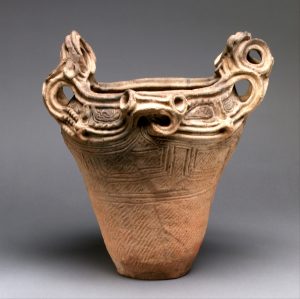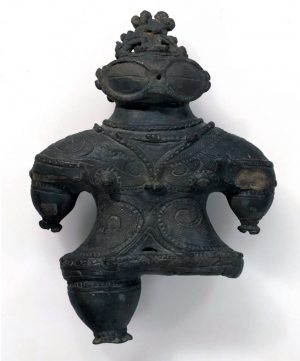Japanese Arts: Jomon Period
 Jomon means chord pattern in Japanese. This represents a technique of decorating jomon period pottery. The women of the Jomon period make the pots by hand. They would build vessels from the bottom from wet coils of wet clay, then mix other materials such as Mica and crushed shells to make the pots. Mica is a mineral dust, used to make cement, makeup, wallpaper, and so much more. Next they smooth out the inside and outside of the pots then decorated with geometric patterns. The designs were made by pressing cord on the soft surface of the clay. They were left out to dry before being put into the fire at a low temperature just reaching the 900 degrees Celsius in an outdoor fire pit. These represented a more complex decoration and design of geometric patterns. They were made with designs as well as colored with natural pigments. These are remarkable skills in aesthetic sense of the people who produced them. It also represented stylistic diversity of different regions of Japan. Other artworks that were made during this period were figurines. They were represented as female figures which focused of the eyes, waist, and hips.
Jomon means chord pattern in Japanese. This represents a technique of decorating jomon period pottery. The women of the Jomon period make the pots by hand. They would build vessels from the bottom from wet coils of wet clay, then mix other materials such as Mica and crushed shells to make the pots. Mica is a mineral dust, used to make cement, makeup, wallpaper, and so much more. Next they smooth out the inside and outside of the pots then decorated with geometric patterns. The designs were made by pressing cord on the soft surface of the clay. They were left out to dry before being put into the fire at a low temperature just reaching the 900 degrees Celsius in an outdoor fire pit. These represented a more complex decoration and design of geometric patterns. They were made with designs as well as colored with natural pigments. These are remarkable skills in aesthetic sense of the people who produced them. It also represented stylistic diversity of different regions of Japan. Other artworks that were made during this period were figurines. They were represented as female figures which focused of the eyes, waist, and hips. 
Jomon period is japan’s Neolithic period. This was the "Stone Age." The people of Japan obtained food by gathering as well as fishing and hunting. They also migrated to cooler or warmer areas as a result in the shifts of weather.
Dr. Sonia Coman, "A brief history of the arts of Japan: the Jomon to Heian periods," in Smarthistory, December 2, 2019, accessed November 24, 2020, https://smarthistory.org/japan-jomon-heian/.
I was very intrigued by the content of this post. The level of detail you went into with the techniques used in the art (especially the pottery), was very informative.
ReplyDeleteI found it very interesting that they made the pots by hand. I also agree with Audrey about the level of detail you went into was very helpful and informative.
ReplyDelete